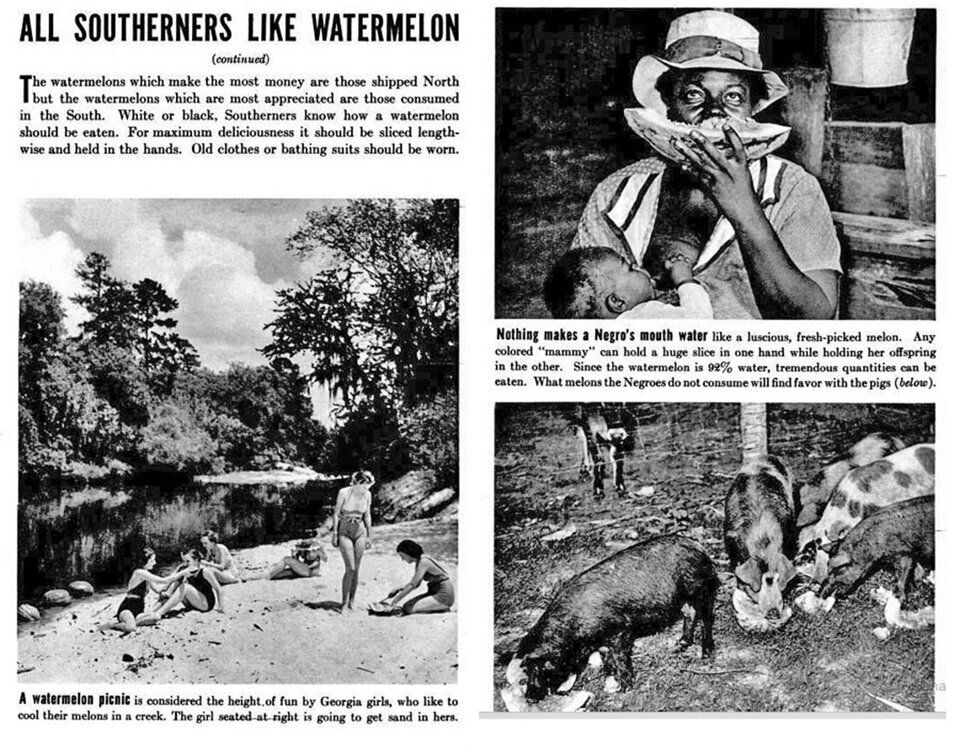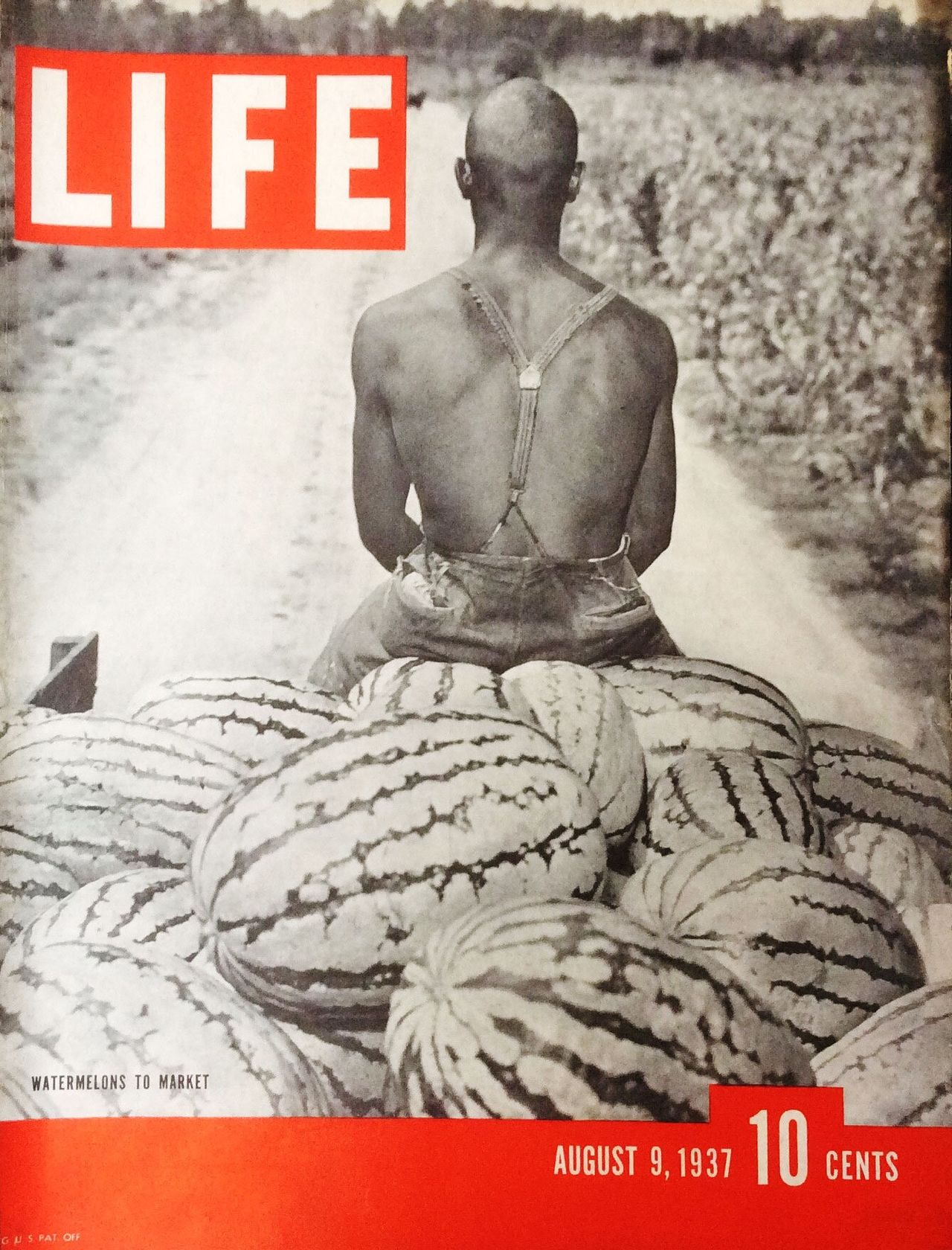The cover of the Aug. 9, 1937 issue of Life Magazine is all about watermelons. On it, several watermelons are wedged into various spots in the back of a pickup truck, packed in along for the ride.
A bald, middle-aged Black man with broad shoulders sits on the back of that truck, shirtless and outfitted in worn pants held up with suspenders. His name is Roy E. Parrish, hailing from Adel, Georgia, and as he sits on the back of the truck, he peers out into sprawling acres of farmland on either side of a winding dirt road.
It appears on the surface to be a glorious tribute to his hard work and harvesting, but it shrouds a much darker and destructive racist stereotype that has persisted even today—one linking African Americans to a cherished pastime of munching on watermelons during the warmer summer months.
But how did it start? How did this green-and-white striped rind and its juicy, red flesh become a racist moniker?
The images disseminated in the Life story, and others like it, played a pivotal role in turning a bigoted assumption into a lasting racist stereotype in the minds of white Southerners ― and Northerners too.

Dr. Psyche Williams-Forson, associate professor and chair of African American studies at the University of Maryland, researches food shaming and policing; she found that stereotypical imagery involving food and Black people began in the early 1900s.
“When I was researching [fried] chicken, I found as many images about watermelon,” she said. “In fact, one of my earliest images I have is of an African American man with a watermelon in each arm and a chicken on the ground, or a pullet as they called it. He was allegedly making the decision about [whether to] put the watermelons down and pick up the pullet. Or does he leave the pullet and take the watermelons?”
One of the first documented of these images appeared in Frank Leslie’s Illustrated Newspaper in 1869. The cartoon, in black and white, shows five little Black boys sitting and standing in a doorway, hungrily devouring watermelon. One of these boys is so consumed with the watermelon, his face is obscured from view. Another has his head leaning outward as he tips what looks like an empty watermelon rind toward his head to catch the lingering bit of juiciness.

In the years and decades following it, newspapers and magazines perpetuated these images, printing them in photo spreads, as stand-alone cartoons and in ad spaces. Beyond media, it started to appear on cookware as salt and pepper shakers, dish rags and paperweights. And each of these depictions was the same: Black people eating this seeded fruit with glee.
“You get this happy darkie concept of a person who just loves watermelon,” Williams-Forson said. “They’re grown in the South, but people in the South and beyond eat them. The difference becomes when Black people are denigrated vis-a-vis these foods. [Then there becomes] another association.”
Debra Freeman, writer and managing editor of Southern Grit Magazine, encountered some of these ads and photos through her mother and was struck with the imaging and the larger implications for them.
“My mom collects Black memorabilia and she was very much into watermelons for a period of time,” she said. “Just looking at the ads with little Black children and the exaggerated mouths with the watermelons was absolutely stunning to see. It was used all over and a calculated decision to stop Black people from empowering themselves.”

At its core, watermelon represented a pathway to economic freedom for formerly enslaved Africans. While enslaved, they were forced to farm watermelons. But once they were free citizens, watermelons provided a way to reclaim their lives and make money. They grew and harvested them, becoming vendors and selling them on street corners.
And of course, that growing business was seen as a threat to white residents in cities across the South during the Jim Crow era. Smithsonian points out that “many Southern whites reacted to this self-sufficiency by turning the fruit into a symbol of poverty. Watermelon came to symbolise a feast for the ‘unclean, lazy and child-like.’ To shame black watermelon merchants, popular ads and ephemera, including postcards pictured African Americans stealing, fighting over, or sitting in streets eating watermelon.”
Freeman points out how illogical and nonsensical these images were to her. Most of these images, for instance, show massive watermelons cut lengthwise, as if to exaggerate the features of African Americans, drawn in the style of the all-too-familiar Black Sambo caricature. But those who eat watermelon often know that eating it in small triangles is typically the way it is done: To eat it the way it is drawn in these pervasive images would be wasteful and incredibly messy.
Cultural symbols are more powerful than they seem. It’s why this imaging has endured, decades after the Jim Crow era of racism crumbled and built itself up into something not new, but different.
It’s why when college cafeterias serve fried chicken and watermelon and someone as famous as Madonna posts a photo of her adopted African daughters eating watermelon, it can be damaging.
The Life Magazine cover is a prime example of how something can appear to be uplifting and affirming, complimentary and positive, but instead contributes to the dehumanisation of an entire group of people. Only when digging into the history, learning about these symbols and unpacking them can they begin to lose their power.

